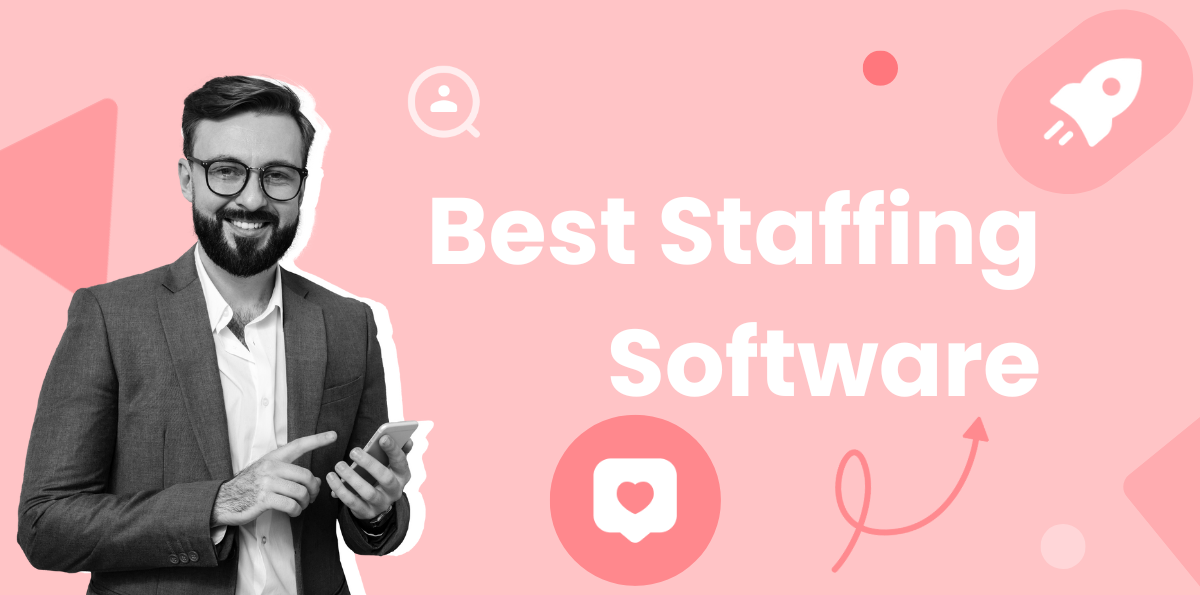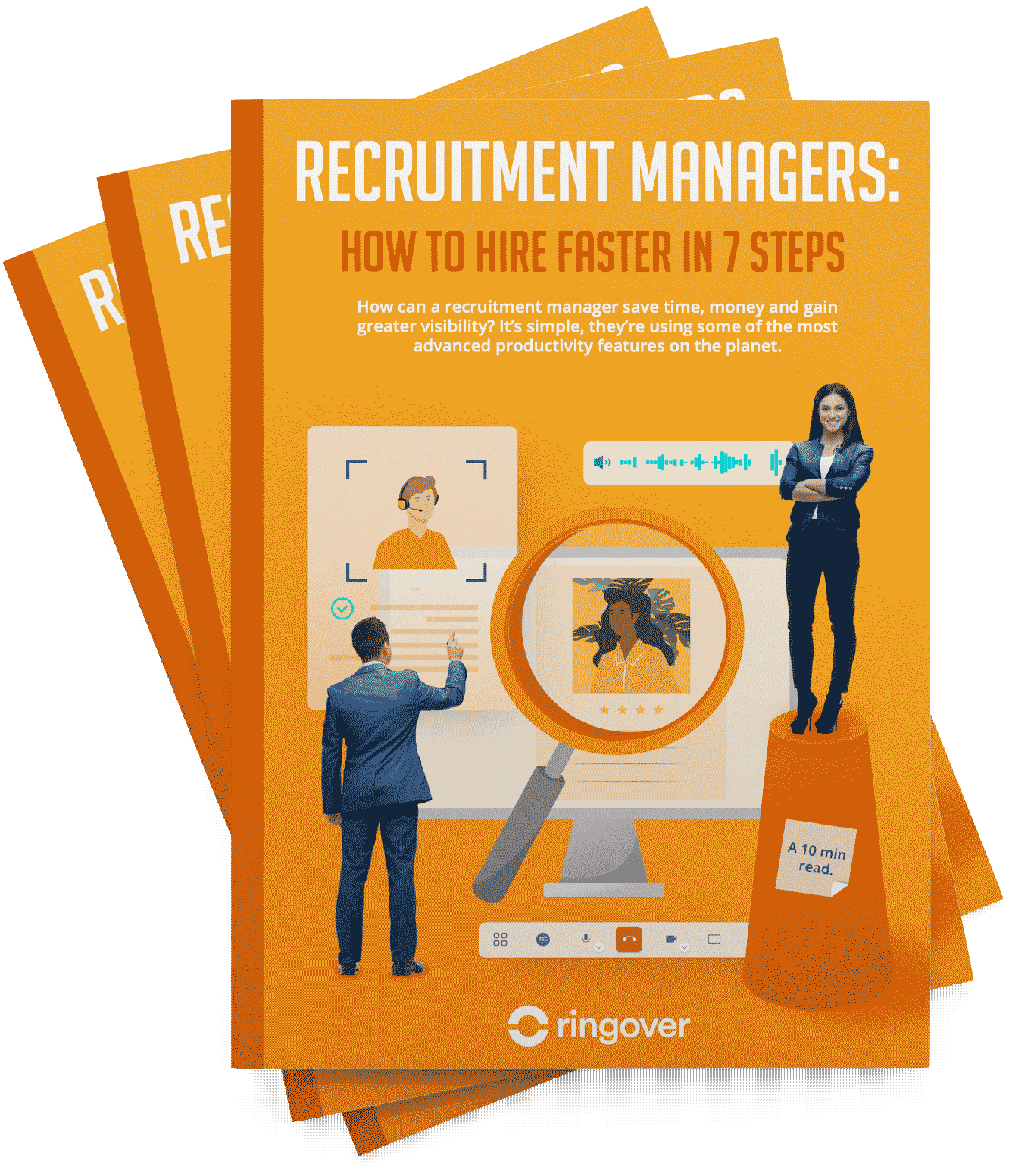Summary
- List: 15 Best Staffing Software (Reviews)
- What is Staffing Software?
- Key Components of Staffing Software
- How to Choose a Recruiting Software
- Typical Features of Staffing Software
- What to Expect: Staffing Software Pricing
- Recruiting Software Benefits
- Downsides of Staffing Software
- Conclusion
- Staffing Software FAQ
It's vital for agencies of all sizes, from small and medium to large enterprises, to choose the best staffing software. This choice is key to staying ahead in the competitive market and efficiently finding and hiring the best talent.
In the current fast-moving recruitment scene, staffing software has expanded to offer features like ATS, CRM systems, job board integrations, and sophisticated recruiting automation software. These functionalities enable recruiters to source candidates more effectively, streamline the recruitment process, and make informed decisions that support their business objectives.
This guide to the best staffing software will explore the top 15 staffing software solutions for recruitment firms, detailing their main features, advantages, and disadvantages. We'll also cover the essence of staffing software, how to select the most suitable one for your business, the expected features, pricing models, and the pros and cons of utilising these tools.
List: 15 Best Staffing Software (Reviews)
1. Ringover

Ringover is a well-rounded suite of communication and productivity tools including a business phone system and omnichannel contact centre software which can be leveraged by staffing and recruiting firms to enhance their hiring processes. For example, Ringover's integration with CRM systems like Salesforce and HubSpot allows recruiters to make calls directly from their CRM, log calls automatically, and access client data in real-time.
This seamless integration streamlines the communication process, ensuring that all interactions with candidates are well-documented and easily accessible. The advanced call analytics feature provides insights into call performance, helping recruiters optimise their communication strategies. Plus, Ringover has advanced call management features, including customisable call routing and intelligent queuing, which can help recruiters manage a high volume of candidate calls efficiently. The integrated team collaboration tools, such as unified and video conferencing, facilitate smooth communication within the recruitment team and with candidates.
The scalable communication solutions ensure that the software grows with the needs of the business. Finally, the real-time call monitoring and coaching tools like call whisper enable team leaders to improve the performance of their recruitment teams.
Ringover Pros✅
- Advanced Call Analytics: Provides detailed insights into call performance to optimise communication strategies.
- Real-time Call Monitoring: Allows team leaders to monitor and coach recruiters in real-time.
- User-Friendly Interface: Easy to set up and use without requiring special hardware or software installations.
- Cost-Effective: Offers flexible and transparent pricing plans.
2. Empower by Ringover
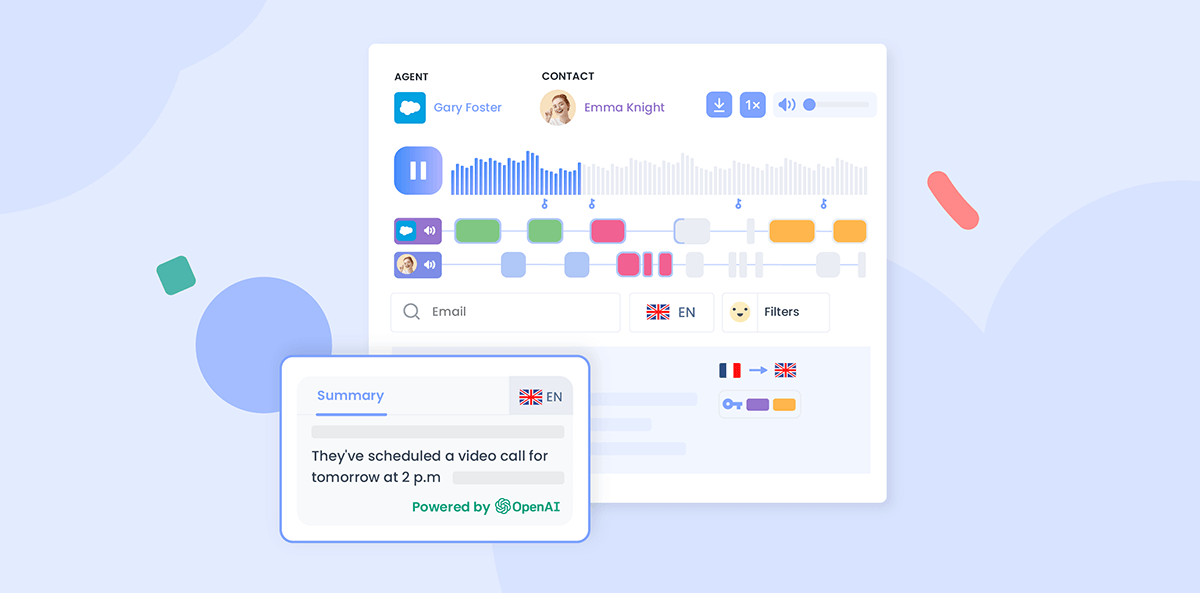
Empower by Ringover is an AI conversation intelligence tool which provides valuable insights into clients, candidates, and even your own team's performance. Empower automatically, records, transcribes, and summarises client and candidate interactions via phone. Then sentiment analysis technology identifies the motions expressed and topics discussed during the call.
The information exchange is thus distilled into searchable and easily digestible data, so you can catch up on even complex conversations easily and efficiently.
In addition to making conversation transcripts searchable by topic and keyword, Empower also offers a comprehensive analytics dashboard for each recruiter, displaying key metrics like how many times they speak, if they take over the conversation in a monologue and more.
Empower by Ringover Pros✅
- Identifies topics, keywords, and sentiments in conversations, aiding in better communication with candidates and customers.
- Delivers actionable analytics and recommendations to boost communication quality and effectiveness.
- Seamlessly integrates with VoIP software Ringover and various business tools like Salesforce, Bullhorn, Hubspot, and more.
3. Zoho Recruit

Zoho Recruit is a popular staffing software known for its user-friendly interface and comprehensive recruitment tools.
Zoho Recruit offers an ATS with a user-friendly interface and comprehensive recruiting tools like candidate sourcing tools and automated workflows to streamline the hiring process. It integrates with other Zoho apps, such as Zoho CRM, to provide a holistic view of candidate interactions. The software also includes features like job board posting, interview scheduling, and candidate relationship management.
Zoho Recruit Pros✅
- User-Friendly Interface: Easy to navigate and use, even for those without extensive technical knowledge.
- Comprehensive ATS: Manages job postings, candidate applications, and interview schedules efficiently.
- Integration with Zoho CRM: Provides seamless integration with other Zoho applications for a unified workflow.
- Automated Workflows: Automates routine tasks to save time and increase productivity.
4. Bullhorn ATS & CRM
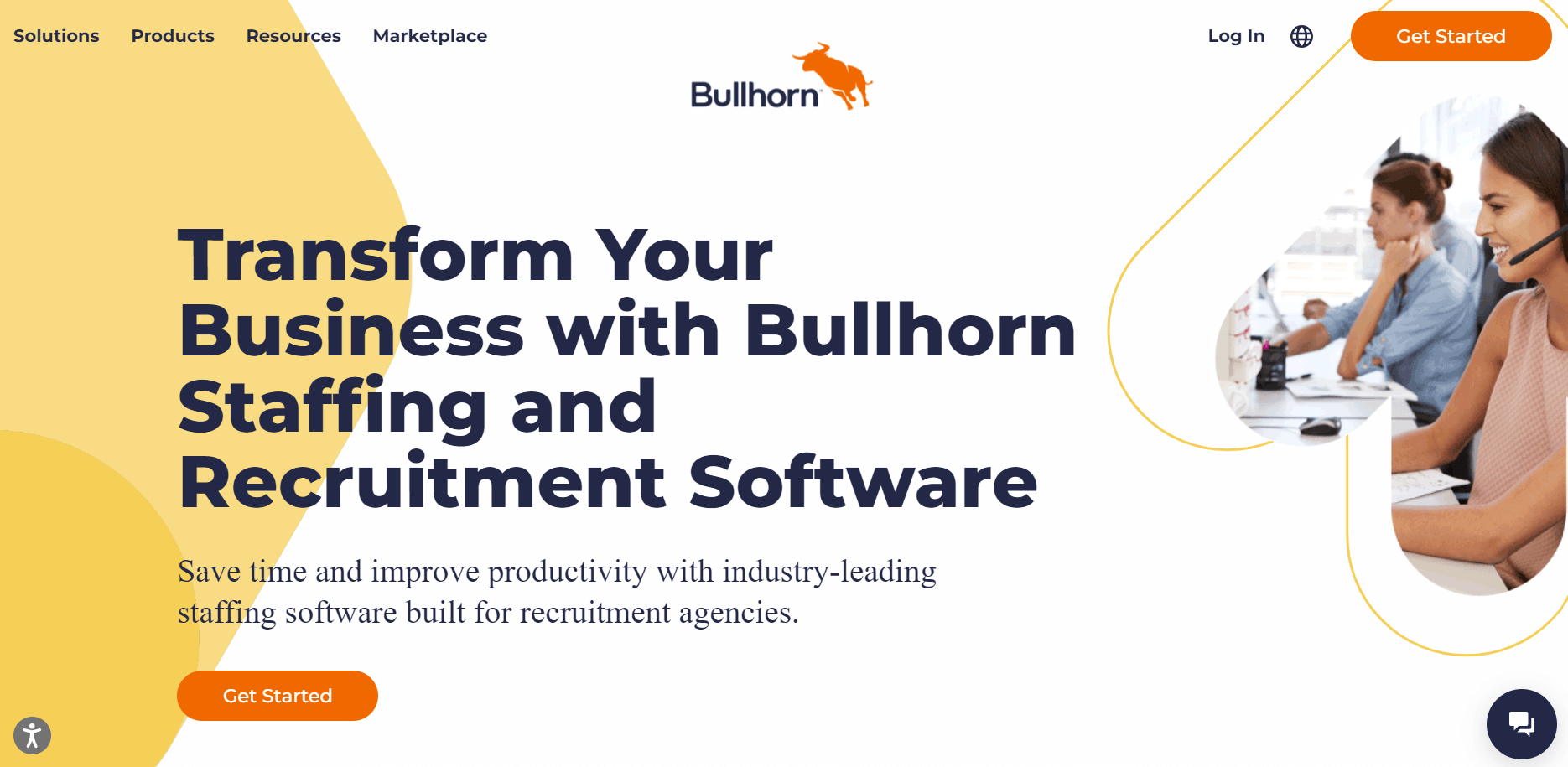
Bullhorn is a robust staffing software that combines an ATS with a CRM, making it a powerful tool for recruiters.
Bullhorn offers advanced features like candidate sourcing, job board integration, and detailed analytics. It also includes tools for managing client relationships and tracking candidate interactions.
The software is highly customisable and integrates well with other business applications.
Bullhorn Pros✅
- Advanced ATS & CRM: Combines applicant tracking and customer relationship management in one platform.
- Customisable: Easily meets the specific needs of the recruitment agency.
- Integration Capabilities: Integrates well with other business applications and job boards.
- Detailed Analytics: Provides comprehensive insights into recruitment KPIs.
5. Workday Recruiting

Workday Recruiting is a recruitment management system that is part of the Workday HCM suite and is designed to streamline the recruitment process for large and medium-sized businesses.
Workday Recruiting offers a unified platform for managing the hiring process, from job postings to onboarding. It includes features like candidate sourcing, interview scheduling, and performance analytics. The software also integrates well with other Workday HCM modules.
Workday Recruiting Pros✅
- Unified Platform: Manages the entire recruitment process from one platform.
- Integration with Workday HCM: Seamless integration with other Workday modules for a holistic HR solution.
- Advanced Analytics: Provides detailed insights into recruitment performance and candidate sourcing.
- User-Friendly: Designed with a user-friendly interface to ease the recruitment process.
Workday Recruiting Cons❌
- Cost: Generally more expensive due to its comprehensive nature and integration with other Workday modules.
- Implementation Time: Can take significant time to implement, especially for larger organisations.
6. BambooHR

BambooHR is an HR management software that includes robust recruitment tools like onboarding software, making it a great option for staffing agencies looking for an end-to-end recruitment tool.
BambooHR offers features like job postings, candidate tracking, and interview scheduling. It also includes tools for managing employee data and onboarding new hires.
The software is known for its ease of use and comprehensive reporting capabilities.
BambooHR Pros✅
- User-Friendly Interface: Easy to navigate and use, even for those without extensive HR experience.
- Comprehensive Reporting: Provides detailed reports on recruitment performance and employee data.
- Integration Capabilities: Integrates well with other HR and business applications.
- Cost-Effective: Offers flexible pricing plans suitable for businesses of various sizes.
BambooHR Cons❌
- Limited ATS Features: While it has recruiting tools, it may not be as robust as dedicated ATS systems.
- Customer Support: Some users have reported mixed experiences with customer support.
7. LinkedIn Recruiter

LinkedIn Recruiter is a powerful tool for sourcing and managing candidates, leveraging the vast network of LinkedIn.
LinkedIn Recruiter offers advanced search features, candidate messaging, and job posting tools. It also includes analytics to help recruiters understand candidate engagement and sourcing effectiveness.
LinkedIn Recruiter Pros✅
- Advanced Search Features: Utilizes LinkedIn's vast network to find and connect with top talent.
- Candidate Messaging: Allows recruiters to message candidates on the platform.
- Job Posting Tools: Enables easy job posting and promotion on LinkedIn.
- Analytics: Provides insights into candidate engagement and sourcing performance.
LinkedIn Recruiter Cons❌
- Cost: Can be expensive, especially for smaller agencies or individual recruiters.
- Limited Integration: While it integrates with LinkedIn, it may not integrate as seamlessly with other HR integrations or CRM systems.
8. Greenhouse

Greenhouse is a comprehensive AI applicant tracking software designed to streamline the hiring process from start to finish.
Greenhouse offers features like job postings, candidate sourcing, interview scheduling, and performance analytics. It also includes tools for managing the entire recruitment workflow and ensuring compliance with hiring regulations.
Greenhouse Pros✅
- Comprehensive Workflow Management: Manages the entire recruitment process in one platform.
- Advanced Analytics: Provides detailed insights into recruitment performance and candidate sourcing.
- Integration Capabilities: Integrates well with other HR and business applications.
- Compliance Tools: Helps ensure compliance with hiring regulations.
Greenhouse Cons❌
- Cost: Generally more expensive due to its comprehensive nature.
- Complex Setup: Can be complex to set up and configure, especially for smaller agencies.
9. Lever
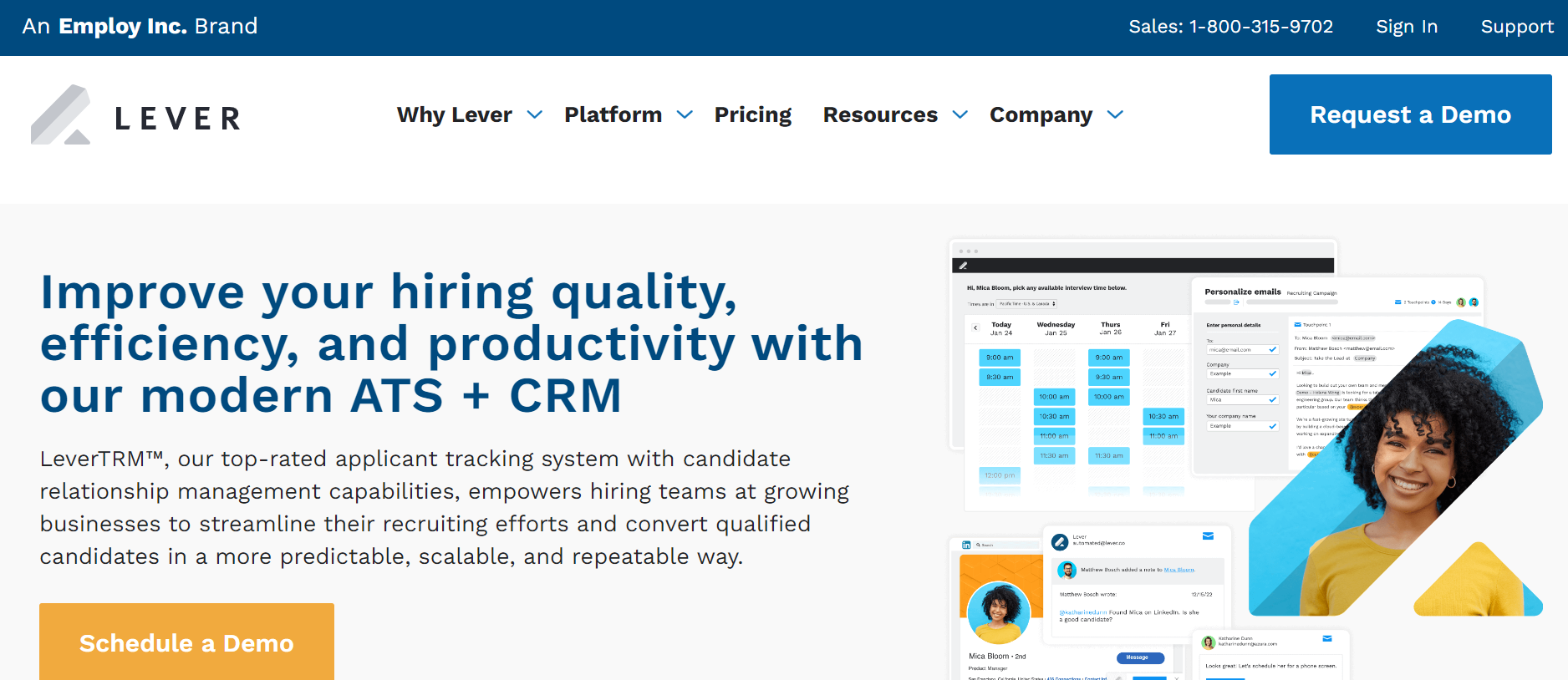
Lever is a modern recruitment software that focusses on candidate relationship management and streamlined hiring processes.
Lever offers features like candidate sourcing, interview scheduling, and performance analytics. It also includes tools for managing candidate relationships and ensuring a positive candidate experience.
Lever Pros ✅
- Candidate Relationship Management: Focuses on building strong relationships with candidates.
- User-Friendly Interface: Designed with a modern and intuitive interface.
- Advanced Analytics: Provides detailed insights into recruitment performance.
- Integration Capabilities: Integrates well with other HR and business applications.
Lever Cons❌
- Cost: Can be expensive, especially for smaller agencies.
- Limited Customization: Some users find the customisation options limited.
10. Workable

Workable is an all-in-one recruitment software that includes an ATS, candidate sourcing tools, and interview scheduling features.
Workable offers a user-friendly interface and integrates well with other business applications. It also includes tools for managing job postings and candidate interactions.
Workable Pros✅
- User-Friendly Interface: Easy to navigate and use.
- Comprehensive ATS: Manages job postings, candidate applications, and interview schedules efficiently.
- Integration Capabilities: Integrates well with other HR and business applications.
- Cost-Effective: Offers flexible pricing plans.
Workable Cons❌
- Limited Advanced Features: May not include as many advanced features as some other staffing software.
- Customer Support: Some users have reported mixed experiences with customer support.
11. Recruitee

Recruitee is a recruitment software designed for small to medium-sized businesses, offering a range of tools to streamline the hiring process.
Recruitee includes features like job postings, candidate sourcing, interview scheduling, and performance analytics. It also integrates well with other HR and business applications.
Recruitee Pros✅
- User-Friendly Interface: Easy to navigate and use.
- Comprehensive ATS: Manages job postings, candidate applications, and interview schedules efficiently.
- Integration Capabilities: Integrates well with other HR and business applications.
- Cost-Effective: Offers flexible pricing plans suitable for smaller businesses.
Recruitee Cons❌
- Limited Advanced Features: May not include as many advanced features as some other staffing software.
- Customer Support: Some users have reported mixed experiences with customer support.
12. SmartRecruiters

SmartRecruiters is a global recruitment marketing and applicant tracking system designed to help businesses find and hire the best talent.
SmartRecruiters offers features like job postings, candidate sourcing, interview scheduling, and performance analytics. It also includes tools for managing the entire recruitment workflow and ensuring compliance with hiring regulations.
SmartRecruiters Pros✅
- Comprehensive Workflow Management: Manages the entire recruitment process in one platform.
- Advanced Analytics: Provides detailed insights into recruitment performance and candidate sourcing.
- Integration Capabilities: Integrates well with other HR and business applications.
- Compliance Tools: Helps ensure compliance with hiring regulations.
SmartRecruiters Cons ❌
- Cost: Generally more expensive due to its comprehensive nature.
- Complex Setup: Can be complex to set up and configure, especially for smaller agencies.
13. Jobvite

Jobvite is a recruitment software that includes an ATS, candidate sourcing tools, and social recruiting features.
Jobvite offers a user-friendly interface and integrates well with other business applications. It also includes tools for managing job postings and candidate interactions.
Jobvite Pros✅
- User-Friendly Interface: Easy to navigate and use.
- Comprehensive ATS: Manages job postings, candidate applications, and interview schedules efficiently.
- Integration Capabilities: Integrates well with other HR and business applications.
- Social Recruiting: Includes features for social media recruitment to reach a broader candidate pool.
Jobvite Cons ❌
- Cost: Can be expensive, especially for smaller agencies.
- Limited Customization: Some users find the customisation options limited.
14. iCIMS
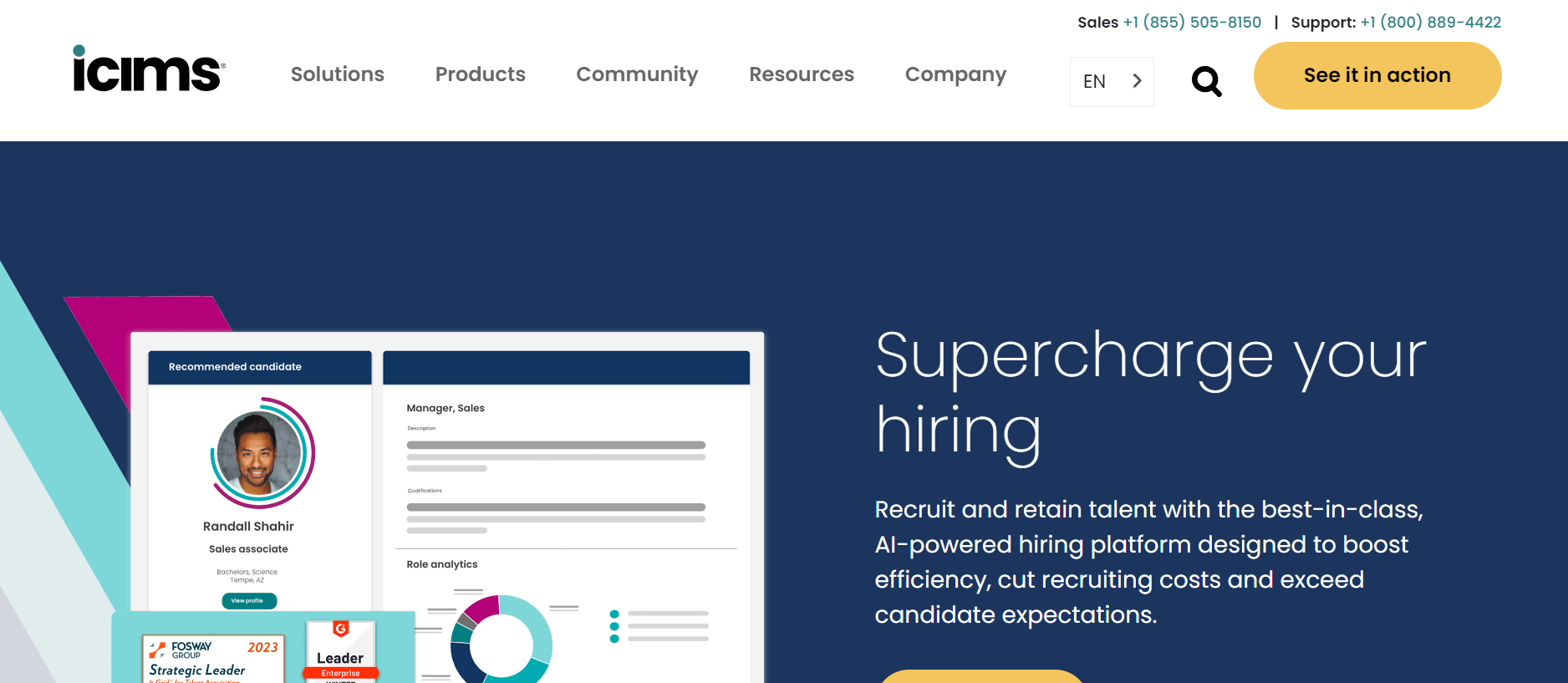
iCIMS is a cloud recruitment software that offers a range of tools to streamline the hiring process, including an ATS and candidate sourcing features.
iCIMS includes features like job postings, interview scheduling, and performance analytics. It also integrates well with other HR and business applications.
iCIMS Pros✅
- Comprehensive ATS: Manages job postings, candidate applications, and interview schedules efficiently.
- Advanced Analytics: Provides detailed insights into recruitment performance and candidate sourcing.
- Integration Capabilities: Integrates well with other HR and business applications.
- Cost-Effective: Offers flexible pricing plans suitable for businesses of various sizes.
iCIMS Cons❌
- Complex Setup: Can be complex to set up and configure, especially for smaller agencies.
- Customer Support: Some users have reported mixed experiences with customer support.
15. Avature
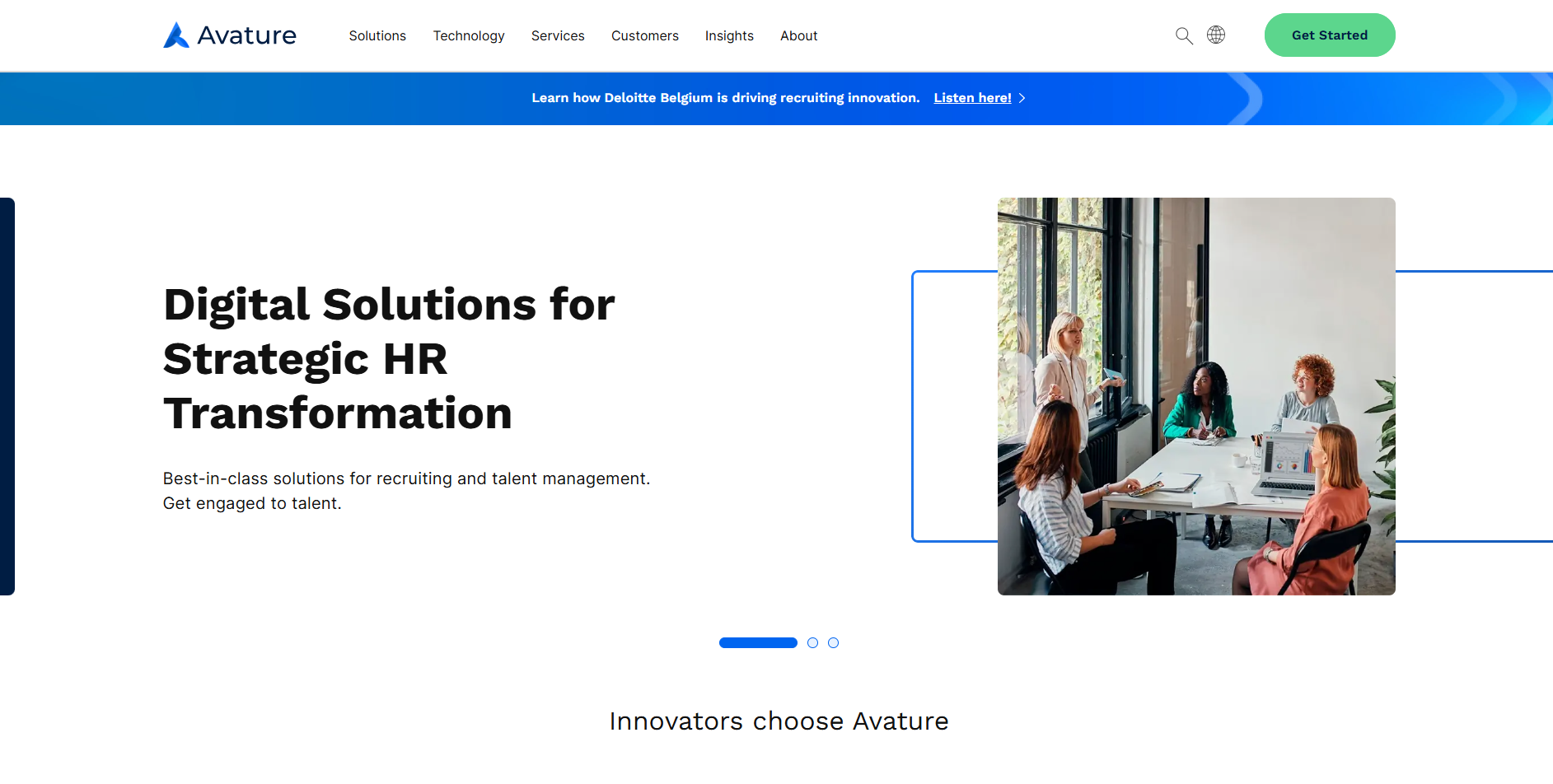
Avature is a comprehensive recruitment software designed for large and medium-sized businesses, offering advanced tools for candidate sourcing and relationship management.
Avature includes features like job postings, candidate sourcing, interview scheduling, and performance analytics. It also includes tools for managing the entire recruitment workflow and ensuring compliance with hiring regulations.
Avature Pros✅
- Advanced Candidate Sourcing: Utilizes advanced algorithms to find and connect with top talent.
- Candidate Relationship Management: Focuses on building strong relationships with candidates.
- Comprehensive Workflow Management: Manages the entire recruitment process in one platform.
- Integration Capabilities: Integrates well with other HR and business applications.
Avature Cons❌
- Cost: Generally more expensive due to its comprehensive nature.
- Complex Setup: Can be complex to set up and configure, especially for smaller agencies.
What is Staffing Software?
Staffing software encompasses a broad array of tools designed to make the recruitment process more efficient for staffing and recruiting agencies. Its primary goal is to aid organisations in finding talent, maintaining relationships with candidates and clients, and monitoring applicant progress during the hiring journey.
Key Components of Staffing Software
Staffing software is comprised of several integral components that collectively enhance the recruitment process. Here's a breakdown of the core categories:
- Applicant Tracking System (ATS): Typically at the heart of the operation, the ATS manages job postings, candidate applications, and interview scheduling. It automates tasks like resume sorting and candidate shortlisting while providing a secure, organised method for handling candidate data.
- Candidate Sourcing: These tools enable recruiters to discover and engage with potential candidates across various platforms, such as job boards, social media, and professional networks.
- Candidate Engagement: Features designed to improve communication with candidates, fostering a positive experience and maintaining their interest and expectations.
- Job Distribution: Tools that simplify the process of posting job openings across multiple job boards and portals to enhance job visibility.
- Onboarding: Software that makes the onboarding process smoother, ensuring new employees are seamlessly integrated into the organisation.
- Functionality and Integration: Staffing software often integrates with other business systems to offer a comprehensive solution. It might, for example, connect with CRM systems for client relationship management and payroll systems for handling hiring and employment finances. This integration centralises data, processes, and workflows, minimising redundant tasks and improving reporting capabilities.
- Automation and Efficiency: A key advantage of staffing software is its ability to automate routine and time-consuming tasks. This not only accelerates the hiring process but also minimises human error and frees up recruiters to focus on more strategic recruitment aspects. Automation in areas like resume screening, candidate communication, and interview scheduling significantly boosts recruitment efficiency.
- Customisation and Industry-Specific Needs: Staffing software can be tailored to meet the unique requirements of various industries and staffing niches. For example, healthcare staffing firms may need different functionalities than technology staffing firms. The software can be customised to include specific features, such as scheduling and onboarding tools for industrial staffing or candidate engagement and redeployment strategies for software engineers.
How to Choose a Recruiting Software
Choosing the right recruiting software is a pivotal decision that significantly influences the efficiency and effectiveness of your recruitment process. Below are essential factors and steps to guide you in selecting the perfect recruiting software for your organisation.
1. Evaluate Your Current Recruitment Process
Understanding your current recruitment process and identifying its challenges is essential before choosing a recruiting software. Analyse your workflow, pinpoint bottlenecks, and determine the necessary features to address these issues.
Examine your recruitment process closely to identify what hinders its efficiency. Whether it's the overwhelming number of resumes, difficulty in engaging candidates, or managing multiple job postings, recognising these challenges is the initial step towards finding an appropriate solution.
2. Key Factors to Consider
- Usability and User Experience: The software's usability is paramount. Its interface should be intuitive and user-friendly, minimising the need for extensive training. An easy-to-navigate platform ensures widespread adoption among your team, allowing recruiters to concentrate on their primary responsibilities instead of wrestling with technology. Seek out tools with neat, organised layouts and uncomplicated procedures.
- Customisation Options: The ability to customise workflows and forms is essential for tailoring the software to meet your specific needs, optimising the hiring funnel to find top talent effectively. Customisable settings let you adjust the software to evolving workflows and preferences, such as prioritising candidate assessments for technical roles or focusing on time-to-fill for seasonal positions.
- Automation and Efficiency: Automation is an important feature of any recruiting software, capable of handling routine tasks like resume parsing, initial screening, and candidate communication. Opt for software that automates complex tasks, allowing your recruiters to dedicate more time to strategic work. Ideal software should automate job postings, candidate sourcing, and interview scheduling.
- Integration Capabilities: Seamless integration with other business applications, such as CRM systems, job boards, and payroll systems, is essential for a streamlined workflow and minimising double data entry. Integration ensures centralised data, processes, and workflows, improving reporting capabilities and reducing errors.
- Data and Analytics: Choose software that offers detailed insights on key metrics like time to hire, candidate quality, sourcing effectiveness, and offer acceptance rates. Such data enables you to refine your hiring process and make well-informed decisions, leveraging data-driven recruitment to connect with exceptional talent.
- Scalability: The software should scale with your organisation's growth, accommodating increasing recruitment demands without compromising performance or usability. Software that grows with your organisation and adapts to changing talent management needs and market conditions ensures long-term effectiveness.
- Mobile Accessibility: Given the mobile nature of many recruiters' work, mobile accessibility is critical. Ensure the software provides mobile-friendly interfaces and apps, enabling recruiters to efficiently manage tasks from any location.
- Cost and ROI: Assess the software's cost against the benefits it offers. Ensure the software aligns with your budget and business objectives, considering the return on investment (ROI). Flexible pricing plans and clear cost structures are also important considerations.
Trial and Feedback
Before finalising your decision, it's wise to trial the software and solicit feedback from your team. This step is essential in confirming the software's fit for your organisation and ensuring its adoption by your team. One huge advantage of Ringover and Empower by Ringover is that they both offer free trials, so you can try before you buy!
By meticulously considering these factors and adopting a systematic approach to evaluating recruiting software, you can choose a platform that meets your unique needs, supports your organisation's long-term growth, and enhances your recruitment process.
Using a staffing software like Ringover improves the quality and efficiency of your communication, which in turn boosts relationships and performance.
Typical Features of Staffing Software
Staffing software comes loaded with features aimed at simplifying the recruitment process, improving candidate management, and boosting overall efficiency. Below, we explore the standard features you'll likely find in contemporary staffing software:
Omnichannel Communications
Having a unified communications software which goes beyond the typical business phone system helps you automatically level up your candidate and client relationships. For example, Ringover helps you effortlessly track interactions with clients and candidates and reach out to them on the right channel, at the right time.
Artificial Intelligence
Though Empower by Ringover functions as a sales enablement tool, it supports successful recruiting efforts by automatically transcribing and summarising phone interactions with clients and candidates. You can even benefit from an integration with Google Calendar to record and transcribe video calls. With Empower's powerful sentiment analysis technology, you'll be able to see the topics discussed and emotions expressed in interactions, ensuring you don't miss and thing and can easily catch up on previous conversations.
Applicant Tracking System (ATS)
An ATS forms the backbone of most staffing software, overseeing the recruitment journey from job posting to candidate onboarding. It's responsible for various tasks such as broadcasting job openings across multiple job boards, storing applicant information, filtering applications for potential fits, and maintaining internal candidate notes within a unified database. Additionally, it generates valuable analytics on the hiring process and supports collaboration among recruiters, hiring managers, and other key players.
Job Distribution and Posting
Staffing software typically includes mechanisms for spreading job postings over a range of platforms, including job boards, career sites, social media, and internal networks. This functionality not only broadens the candidate pool by enhancing job visibility across multiple venues but also streamlines the job posting process, saving recruiters valuable time and energy.
Candidate Sourcing
Tools for candidate sourcing empower recruiters to discover and engage with prospective candidates through various channels. Features may cover resume parsing for extracting pertinent details from resumes and candidate screening to filter individuals based on set criteria like qualifications, experience, and skills.
Interview Coordination
Integral to staffing software is interview scheduling technology, which simplifies arranging interview dates and times with candidates and hiring managers. This capability helps prevent scheduling clashes and ensures all parties are well-informed and involved throughout the interview phase. Automated reminders and alerts keep candidates and interviewers aligned and on schedule.
Candidate Management and CRM
A comprehensive candidate management system coupled with CRM is essential in staffing software. These platforms offer a centralised location for recruiters to view, organise, and handle candidate profiles and applications, track candidate progress, transition them through various hiring stages, and collaborate with colleagues. The CRM feature is instrumental in nurturing relationships with candidates, facilitating rapid position filling as opportunities arise.
Time and Attendance Tracking
For agencies dealing with temporary or contract staffing, tracking time and attendance is essential. This feature helps monitor the hours worked by temporary staff, ensuring precise billing and payroll operations. It's also key in managing the workforce effectively and adhering to labour laws.
Reports and Analytics
Advanced reporting and analytics are standard in staffing software, offering insights into the recruitment workflow. These reports can pinpoint bottlenecks, drop-off points, and other improvement areas, enabling recruiters to refine their approach, enhance candidate quality, and decrease the time-to-hire.
Integration Capabilities
The capacity for integration with other business tools is a hallmark of modern staffing software. Integrations with platforms like Slack for business communication, DocuSign for eSignatures, and HRIS systems streamline operations, boost collaboration, and expedite the onboarding process. These integrations extend the staffing software's utility, making it a more all-encompassing solution for talent acquisition and management. Understanding these features allows for a better assessment of which staffing software best matches your organisation's needs and objectives.

What to Expect: Staffing Software Pricing
When delving into the realm of staffing software, it's vital to grasp the various pricing models and the elements that affect the overall costs. This guide provides a comprehensive overview of what you can anticipate in terms of staffing software pricing.
Types of Pricing Models
Staffing software vendors usually present a range of pricing models, designed to accommodate the diverse needs and sizes of businesses.
Per-User Pricing
This approach bills based on the number of active users within an organisation. It's particularly advantageous for smaller teams or agencies aiming to meticulously manage expenses, as it allows payment for only the active users. However, this model may become expensive for agencies experiencing rapid growth.
Feature-Based or Tiered Pricing
Here, agencies can select from various tiers, each offering an ascending array of features. This model is perfect for agencies desiring flexibility, enabling them to upgrade from a basic plan to more advanced tiers as their needs grow. For instance, Ringover provides tiers like Smart, Business, and Advanced, each with a different set of functionalities.
Subscription-Based Pricing
This model entails a regular payment, typically monthly or annually, granting access to the software. It's known for its flexibility and cost predictability, making it a fit for companies of all sizes. This model ensures access to all features, regardless of user count, which is beneficial for larger agencies.
Custom Pricing
Custom pricing caters to large enterprises with specific, complex needs. Vendors collaborate with these organisations to develop bespoke solutions that align with their unique requirements, especially useful for businesses seeking specialised features or integrations not available in standard plans.
Factors Influencing Pricing
Several aspects can dictate the pricing of staffing software, including:
Scale of Operations
The size of your business plays a critical role in determining the cost of staffing software. Larger enterprises with more comprehensive workforce needs typically face higher costs due to the need for more sophisticated, customisable solutions.
Features and Customization
The assortment of features and customisation level significantly influences pricing. Basic packages might offer core functionalities such as candidate tracking and job posting, while more advanced packages could include analytics, integration capabilities, and customisable workflows. The greater the need for features and customisation, the higher the cost.
Deployment Method
Whether the solution is cloud-based or on-premises affects the total cost. Cloud-based solutions generally come with subscription-based pricing, offering scalability and flexibility. Conversely, on-premises solutions might have higher upfront costs but provide more data control.
Integration with Existing Systems
The ability to seamlessly integrate with current systems, like HR or payroll software, can also influence the cost. Compatibility and ease of integration lead to a more efficient workflow, potentially affecting the pricing structure.
Cost Ranges
The investment in staffing software can vary widely, influenced by the selected pricing model and features. General cost expectations include:
- Per-User Pricing: Costs usually run into the hundreds of dollars per user per month, varying by vendor and included features.
- Subscription-Based Pricing: This model provides more predictable expenses, with fees ranging from reasonable options, like Ringover or Empower by Ringover. Ringover begins at £19 per user/month, while Empower is just £69 per user/month, despite the powerful AI insights it delivers.
- Tiered Pricing: Costs differ based on the chosen tier, with basic plans starting at a few hundred dollars per month and more advanced plans significantly higher.
Budget and Cost Flexibility
Your budget will significantly dictate the most viable pricing model. Subscription-based models, though potentially more costly upfront, offer stability and comprehensive access for larger teams. Per-user and per-feature plans may suit agencies focusing on budget control better. Balancing the costs with the benefits and ensuring the selected model meets your business objectives and financial limits is essential. With a clear understanding of these pricing models and influencing factors, you can make a well-informed choice on staffing software that aligns with your organisation's needs and budget.

Recruiting Software Benefits
Enhanced Productivity
Recruiting software significantly boosts HR teams' productivity by automating routine tasks such as resume screening, job posting across multiple job boards, and interview scheduling. This automation allows for a focus on strategic activities like interviewing, training, and fostering candidate relationships, thereby streamlining the hiring process and emphasising human interaction and judgment.
Improved Candidate Quality
Recruiting software excels in attracting and filtering high-quality candidates efficiently. By automatically screening resumes against predefined criteria, it ensures that only the most suitable candidates advance, leading to optimal job matches and lower turnover rates. Advanced search functionalities and keyword filtering within resumes empower recruiters to swiftly identify leading talent from vast applicant pools.
Greater Reach and Engagement
Recruiting software broadens your recruitment efforts, enabling connections with both active and passive candidates. It facilitates social media recruitment, effortless content creation, and automated messaging, which enhances candidate engagement and keeps them informed throughout the hiring journey. Such improved engagement not only enriches the candidate experience but also elevates your organisation's appeal, increasing the chances of successful hires.
Centralised Management and Collaboration
A centralised platform provided by recruiting software simplifies managing all recruitment aspects, from job postings and applications to candidate tracking and data storage in one location. This centralisation fosters better collaboration among hiring teams, ensuring real-time access to consistent information for all stakeholders. Role-based permissions and instant notifications further improve collaboration, minimising miscommunication and making decision-making more efficient.
Compliance and Reduced Bias
Recruiting software supports compliance with hiring regulations and minimises unconscious bias in the hiring process. Standardised workflows and compliance tools align hiring practices with legal and ethical standards, promoting a fair, inclusive workplace and preventing hostile work environments. Such standardised processes enable more objective hiring decisions, contributing to workforce diversity and inclusivity.
Cost Efficiency
As a cost-effective solution, recruiting software reduces expenses tied to traditional hiring methods by integrating job posting, screening, and communication onto a single platform. This consolidation cuts advertising costs and decreases the financial impact of extended vacancies. Moreover, automating tasks like resume screening and interview scheduling shortens the time-to-hire, further reducing hiring costs.
Data-Driven Insights
Recruiting software offers valuable analytics and reporting features, enabling informed decision-making by recruiters and hiring managers. These insights can spotlight bottlenecks in the hiring process, assess the efficacy of various sourcing channels, and track candidate quality and retention. Leveraging these insights allows organisations to refine their recruitment strategies continuously, achieving superior hiring results and enhanced overall performance.
Downsides of Staffing Software
Financial Investment
One of the significant downsides of staffing software is the financial investment required. Many providers charge a monthly or annual subscription fee, which can be a burden, especially for small businesses or startups. Additionally, there may be costs associated with setting up the software, customising it, and training staff to use it effectively. This initial financial outlay can be a barrier for organisations with limited budgets, and the ongoing costs need to be carefully weighed against the potential benefits.
Learning Curve and Training
Staffing software often requires a learning curve, and training is usually necessary to ensure that all users are comfortable with the system. This can lead to a temporary dip in productivity as staff adjust to the new tools and processes. The complexity of some systems means that specialised training may be required, which can be time-consuming and may divert resources away from other critical tasks.
Technical Issues and Downtime
Like any software, staffing solutions are not immune to technical issues. These can include system errors, downtime, and security risks, all of which can disrupt the recruitment process. The reliance on technology means that any technical problems can have a significant impact on operations. Technical issues can lead to delays in hiring, lost candidate data, and other operational inefficiencies, highlighting the need for reliable support and backup plans.
Integration Challenges
Integrating staffing software with existing systems can be complex and time-consuming. This may involve IT support and ongoing maintenance to ensure seamless integration, which can be a challenge, especially for organisations with legacy systems or disparate databases. Integration issues can lead to manual data transfer, duplicate entries, and other inefficiencies, undermining the benefits of using the software.
Risk of Over-Reliance on Technology
While staffing software automates many tasks, there is a risk of over-reliance on technology. This can lead to a more impersonal hiring process, where candidates feel treated as numbers rather than individuals. It is important to balance automation with personal interactions to maintain a human touch in recruitment efforts. An over-reliance on technology can also result in candidates feeling disconnected from the hiring process, potentially leading to lower candidate satisfaction and engagement.
Limitations on Candidate Pool
The use of ATS and other automated screening tools can sometimes limit the candidate pool. These systems may filter out qualified candidates who do not use the exact keywords or formatting required by the system. This can lead to missing out on top talent due to technical or algorithmic issues. The rigid nature of keyword-based screening can overlook candidates with unconventional backgrounds or experiences, reducing the diversity and quality of the candidate pool.
Lack of Customization
Some staffing software solutions may not offer the level of customisation needed by an organisation. This can limit the effectiveness of the recruitment process, as the software may not align with the specific hiring processes or company culture. Limited customisation options can prevent the software from being fully integrated into the organisation's workflow, reducing its overall value and impact.
Maintenance and Updates
Staffing software requires ongoing maintenance and updates to ensure it remains effective and secure. This can involve additional training for staff and may disrupt normal operations, especially if updates are not well-managed. Regular updates and maintenance are necessary to fix bugs, add new features, and enhance security, but these can sometimes cause temporary disruptions to the recruitment process.
Conclusion
By streamlining the recruitment process, staffing software can reduce time-to-hire, improve client relationships, and enhance the overall candidate experience via optimised communication. When choosing software, consider factors such as scalability, integration capabilities, user experience, and customisation options to ensure it aligns with your business needs. Take action today by starting a free trial of Ringover or Empower by Ringover, which will allow you to efficiently build optimised and valuable candidate and client relationships.
Staffing Software FAQ
What is the best software for recruitment?
The best software for recruitment depends on the specific needs and size of your organisation. For example:
- Ringover offers various productivity features to ensure efficient and successful communication during the recruitment process, client nurturing, and even customer service via call centre software.
- Empower by Ringover brings the power of artificial intelligence to hiring, delivering valuable insights into candidate and client interactions.
- Greenhouse is highly regarded for its customisable workflows, interview kits, and advanced analytics, making it ideal for companies needing structured hiring processes.
Each of these platforms excels in different areas, so it's important to evaluate your specific requirements before making a decision.
Which recruitment platform is best?
The best recruitment platform varies based on your specific needs and the type of hiring you are doing. Here are a few examples:
- Indeed is a leading job board that attracts millions of job seekers and offers advanced search options and an employer dashboard, making it valuable for any recruitment strategy.
- LinkedIn is the largest professional network and offers powerful advanced search filters and job posting features, making it ideal for high-volume candidate sourcing.
- HireRight is best for on-demand background check services, ensuring a safe and secure hiring process with detailed reporting and reference verification.
Each platform has its strengths, so it's important to choose one that aligns with your hiring goals and candidate sourcing strategies.
Which recruitment CRM is best?
The best recruitment CRM system depends on the complexity of your recruitment processes and the level of customisation you need. Here are some top options:
- Bullhorn is a combined ATS and CRM system that excels at increasing sales, streamlining operations, and enhancing candidate engagement. It is particularly useful for staffing agencies looking to make faster placements and improve retention.
- Vincere is a sophisticated CRM designed for recruitment agencies, offering lead management, automated workflows, and insightful data analysis. It is scalable and integrates seamlessly with other tools.
Each CRM has unique features, so it's important to select one that fits your agency's specific needs and workflow. By understanding these answers, you can make more informed decisions when selecting the right staffing software for your organisation.
